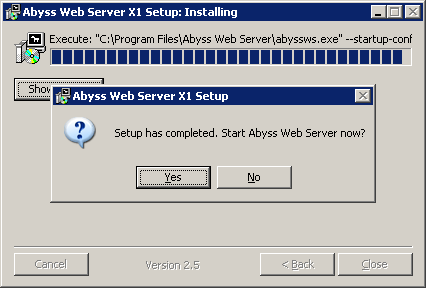

- #ABYSS WEB SERVER HTTPS MAC OS#
- #ABYSS WEB SERVER HTTPS SOFTWARE#
- #ABYSS WEB SERVER HTTPS CODE#
- #ABYSS WEB SERVER HTTPS LICENSE#
- #ABYSS WEB SERVER HTTPS DOWNLOAD#
Furthermore, it helps you gain portability, because there’s no way to make your application dependent on the Web server, which can happen with embedded interpreters such as mod_php. FastCGI ended up taking a back seat.įastCGI allows you to separate the applications from the server and even restart them independently. Abyss employs FastCGI.Īt around the same time FastCGI took off, Apache developed a different technique, using modules such as mod_php, which also didn’t require multiple processes, but provided closer integration between the server and the application and had better performance than CGI. When there are multiple simultaneous requests, FastCGI either multiplexes the requests (so a single connection can process them all) or uses multiple connections. To overcome these deficiencies, a company called Open Market developed FastCGI, which uses a single process to handle many requests during its lifetime. A heavy workload could easily overwhelm your server.

This simple approach could consume lots of resources, because each program execution meant creating a new process, which required both time and memory. When the Web server received a request, it could answer it by executing a program (with certain parameters) and sending the result (probably with some extra headers and information) back to the browser for display. In the early years of the World Wide Web, Common Gateway Interface (CGI) was the standard way for serving Web pages. If everything goes right, you’ll see the Abyss Web Server Console, and Abyss will be up and running navigate to to check it out. You must then immediately enter them to get to the configuration form. (According to the online documentation, you should be able to choose from among English, French, Arabian, German, Chinese, and more, but only the first three were available when I ran it.) On the next screen, create an Abyss administrator username and password. Navigate to and select the default language. The server will confirm that it’s running on port 8000, and let you know you can configure it at port 9999.
#ABYSS WEB SERVER HTTPS SOFTWARE#
(Running any Web server as root is usually not a good idea, so this behavior makes sense.)Īfter you complete the installation, start the software with the command. In any case, you must run it as a common user if you try to run it as root, Abyss will complain and not run. You can run Abyss either directly from the console (and shut it down with Ctrl-C) or as a daemon, by adding the -d parameter.
#ABYSS WEB SERVER HTTPS DOWNLOAD#
You’ll likely want to try out the free edition before committing to the paid one, so go to the Abyss download site, get the Linux version, and untar it in its own directory (a good choice might be $HOME/bin).

#ABYSS WEB SERVER HTTPS LICENSE#
After a year you can opt to extend your license (for an additional payment of $25, or $40 for two years’ worth) or just keep the latest version. When you purchase the X2 version, you get a year’s worth of free updates and support. The X1 version is almost as fully featured as the X2 one, and it has no restrictions, nag screens, time limits, or any similar behaviors. Abyss isn’t open source software, but it provides two versions: X1, which is free, and X2, which costs about $60.
#ABYSS WEB SERVER HTTPS CODE#
Its simple installation and setup (no obscure text configuration files) allows you to code your site with PHP, Perl, Python, Ruby, and even ASP.Net, if you’re using the Windows version.
#ABYSS WEB SERVER HTTPS MAC OS#
In development since 2002, its current version (2.5) runs on Linux, BSD, Windows, and Mac OS X. This will help eliminate one source of connectivity problems (DNS reachability/name resolution).If you need to set up a secure, easily configurable Web server in as short a time as possible, then Abyss Web Server might just be the product for you. When specifying the host to connect to, it is often better to specify the IP address in the URL rather than the FQDN.If that is your situation you will need to configure the web server to listen on another port (for example, 8080), and then remember to specify that port in the URL. Also be aware that some server ports may already be in use by the OS, or administrative restrictions forbid access to privileged ports (1-1023).This article on stackoverflow provides some useful information. Be aware that you may need to add a MIME type like the following otherwise files that lack an extension, such as "kernel" used when netbooting, will not be served. Microsoft Internet Information Services (better know as IIS) - although neither "free" nor open-source - is often already readily available in most Windows environments.


 0 kommentar(er)
0 kommentar(er)
